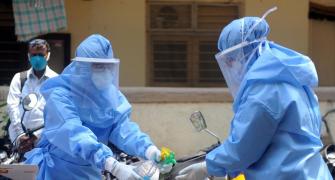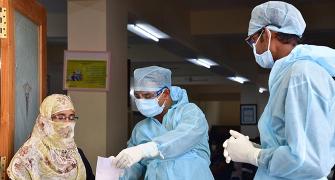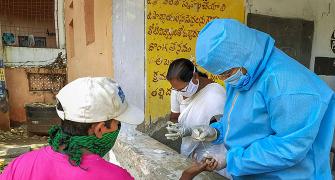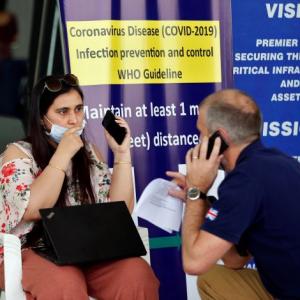'We know there will be an end to this epidemic temporarily.'
'We probably should get a couple of years break before it comes again.'
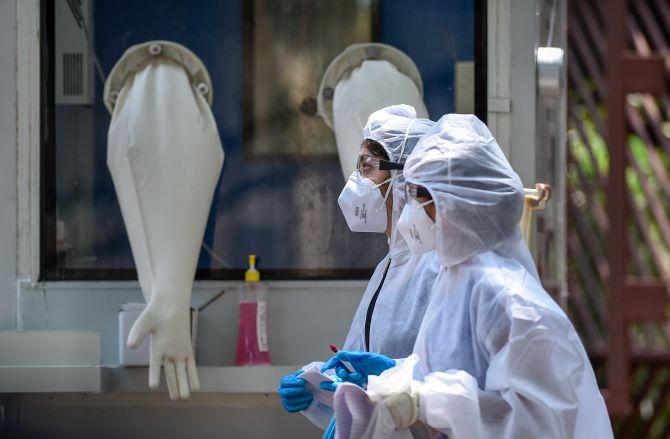
Dr Jayaprakash Muliyil is one of India's leading epidemiologists.
Dr Muliyil has helmed the leprosy control programme and is a former principal of the prestigious Christian Medical College in Vellore, Tamil Nadu.
"Fortunately, most epidemics do not have to infect every last individual in the country till the epidemic is over. There is a point at which most epidemics stop," Dr Muliyil, below, tells Rediff.com's Archana Masih in the first of a two-part interview.
The purpose of the lockdown was to slow the spread and ramp up the medical response. How has India fared in this regard?
Did it make an impact? Yes. There was a change in the rate of transmission.
Did we increase our capacity for taking care of sick patients? My understanding is that a lot of work has gone into it.
India is a large country and I can't answer for the entire country, but I am quite impressed by the work taken up by many states.
More importantly, many people in India have now heard of this disease. The lockdown has not only prepared us, it has also informed us about this crisis.
But unfortunately, not everyone has heard the right thing. A large section is dwelling under fear.
Fear increases the possibility of your response being negative. We can't afford that. It is the responsibility of journalists to create an atmosphere of positive thinking and confidence.
This disease is something we wished had never happened, but it has. The way we face it will make it lighter or severe. It is our response that matters.
The important thing is whether the information that people are receiving is a negative or positive one.
Fear psychosis will make things very difficult.
What is your understanding about the information that has gone out? Has it made people anxious and fearful?
For example, there was a news item on the front page of a newspaper that said that contrary to popular belief it appears that children also can be infected by coronavirus. The report was accompanied with a picture of children standing behind a wire mesh and anxiously looking out.
There is no such belief that children will not get infected. This is a misinterpretation of facts.
Every calamity has some good aspects and the good aspect of this calamity is that children are spared. They will not die.
Very few diseases come with that blessing. Instead, we have managed to twist the information in such a way that anyone who reads it casually will be alarmed.
To make information newsworthy sensationalism is added and in the process you create misinformation that could hurt us all.

You have said that the lockdown slows the rate of infection, but it is not the solution. What should be the way ahead for us after the lockdown ends on May 3? How will life change?
If you stop moving and stay in your house, the transmission will decrease, but that is not a great discovery. That is the fundamental feature of an epidemic which is moving from person to person.
If we keep inside, naturally there will be a reduction, but the virus doesn't go away. It is still hanging around.
The point is that all of us are susceptible to this infection.
As long as this continues, you cannot be free of the disease and the moment you start moving it will attack you again.
The lockdown was done to buy time. How much more time we need to buy, we don't know.
How much time can we afford to buy?
Would you like to believe that is possible to enforce a tight lockdown for two years while we wait for a vaccine?
Is it possible to do that to take care of one disease?
Please remember there are other diseases like diphtheria, whooping cough that are killing diseases among children.
Immunisation has been disrupted at the moment so we have to be judicious. That is what we need to worry about.
We know we have to lift the lockdown some time. If we don't, our agriculture, industry and economy will suffer and we will be faced with other health hazards which is inevitable.
It is a problem if you have other medial emergencies during this time like acute chest pain and are unable to reach hospital under the current circumstances. Many hospitals have been closed down because of COVID-19 cases within the hospitals.
It has happened in Mumbai. At least four hospitals were shut because their staff were infected.
Yes, I think we are probably not thinking things through logically. We have to deal with COVID-19, at the same time we got to keep living.

What can we expect as we start opening up again after the lockdown?
The infection will pick up. There is no doubt about that.
If you panic when it does and again impose a lockdown, it will be a miserable situation because there cannot be a lockdown every other week.
My worry is that people will die and the second thing is that we have to think how long will it take for the epidemic to pass through.
Fortunately, most epidemics do not have to infect every last individual in the country till the epidemic is over.
There is a point at which most epidemics stop. These epidemics are called person-to-person epidemics -- it moves from one person to the other.
The virus is continuously finding new susceptible patients, but as time goes with the infection spreading there is a proportion of the people in the population who have already been infected and have become immune.
In other words, it is difficult to 'find susceptibles' in the population.
That particular point is called herd immunity. At a particular threshold of herd immunity, the whole epidemic suddenly comes to a standstill.
It almost comes as a magic that after so many cases every day, suddenly you notice a sharp fall. That is usually how an epidemic ends.
Is there an example in the recent past of an epidemic coming to an end after running its course?
In 2009, this is exactly what happened with H1N1.
When it reached 40% infections, it stopped and there was a long pause because the proportion (of the population) susceptible increased with new herds.
We produce 28 million children every year, the population increases and they are all susceptible -- but many of these diseases come in cycles.
Cyclicity in the epidemiology of infectious diseases is the pattern of occurrence of a disease in the population. It enables the population to have a higher density of susceptibles.
The measles cyclicity was three years, German measles 7 years so on and so forth.
We don't know what it is going to be for this particular virus, but we know there will be an end to this epidemic temporarily.
We probably should get a couple of years break before it comes again, but that is provided we have reached a point of saturation of reaching the herd immunity.
For argument, let's say that point is something like 60%, so once 60% have been infected then the remaining 40% gets a free ride.
They will not get an infection now, they can get it again when it comes back two years later. But we get a respite and by that time hopefully a vaccine will be available.
So there is a light at the end of the tunnel. Everything is not lost.

